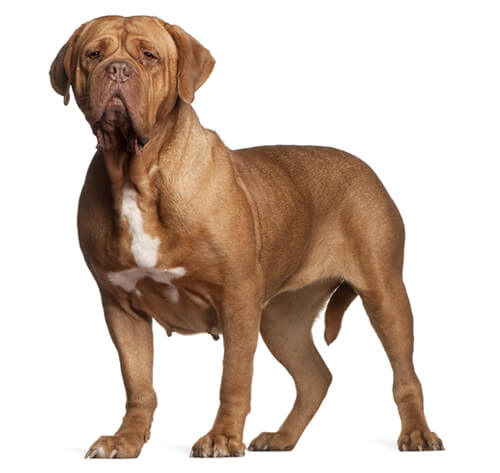
The Dogue de Bordeaux is a powerful, muscular French breed with an instinct for guarding. Though the breed’s appearance can be intimidating, he is a gentle companion with a patient, calm temperament. Fiercely loyal and devoted, he is an excellent guard dog. The Dogue de Bordeaux is known for drooling and snoring but is easy to care because he requires minimal grooming and moderate exercise.
DID YOU KNOW? A Dogue de Bordeaux named “Beasley” appeared as the slobbery but loveable “Hooch” in the 1989 film, “Turner and Hooch,” starring Tom Hanks. Throughout history, the Dogue de Bordeaux has been a guardian, hunter and fighter. He was trained to bait bulls, bears and jaguars, hunt boars, herd cattle, and guard homes.
ALSO KNOWN AS: Dogue de Bordeaux, Bordeaux Mastiff, French Mastiff, Bordeauxdog
The need-to-know
- Dog suitable for experienced owners
- Extra training required
- Enjoys active walks
- Enjoys walking an hour a day
- Giant dog
- Minimum drool
- Requires grooming once a week
- Non hypoallergenic breed
- Quiet dog
- Guard dog. Barks, alerts and it's physically protective
- May require training to live with other pets
- May require training to live with kids
Personality

The Dogue de Bordeaux is a devoted companion that bonds closely with their family and will protect them and their territory if they feel it is threatened. Well-bred, socialised and trained, they are good with children and will accept other household pets if introduced to them when young. They may be aloof - or even positively discouraging - with strangers. They love to please and need to be trained in a consistent and calm manner as they can be surprisingly sensitive.
History and Origins

Country of Origin: France
The precise origin of this breed is unknown with some thinking that is it was originally an ancient Roman breed while others suggest it is descended from the Tibetan Mastiff and the Greek Molossus. Others say it has always been a French dog that has slowly been developed over 2000 years. Whatever their history, the Dogue de Bordeaux started their working life as a highly successful fighting dog and was pitted against bulls, bears and other dogs. As well as being a fighter, the Dogue turned their paws to other roles and over the years has been a war dog, a guard dog, a hunting dog and even a cattle driving dog. It was this latter role that saved the breed after the French Revolution when most noble dogs met the same fate as their noble masters. Those working as mere ‘butcher’s dogs’ (who may indeed have been the more peaceable individuals), survived and were later able to re-establish the breed. As part of this re-establishment, they were crossed with the Bulldog which reduced their size.
Nutrition and Feeding

Giant-breed dogs, as well as having giant appetites, benefit from a different balance of minerals and vitamins, supporting different joint and cartilage needs. The Dogue de Bordeaux is prone to bloating and stomach problems; try feeding smaller, more frequent meals to help minimise the risk.
Exercise

They do not require as much exercise as may be expected – about an hour daily should be sufficient for an adult but this is better split into several short walks. They do enjoy spending time outside in the garden however, as long as it’s secure and they have both shade and constant access to water. Too much exercise too young can lead to bone and joint problems in later life and so should be carefully monitored.
Other Information

Health and Common Issues
As with many breeds, the Bordeaux breed can suffer from hip dysplasia (a condition that can lead to mobility problems). Hip scoring of dogs prior to breeding is therefore important. They are also prone to skin infections in the excessive skin folds. As they are a brachycephalic breed (short nosed), they can suffer from breathing problems and are likely to be unable to cope with heat or over-exercise.
Space Requirements
This is a dog who needs a lot of space both inside and out. Gardens should be securely fenced with no access to casual visitors.
Best Family Dog Breeds
The Dogue de Bordeaux can make a good family dog where there are older sensible children but is too large and often a little clumsy to be good with younger ones. Their aloofness with strangers means they are not good in households with lots of visitors of any age. While many dogs are traditionally thought of as being good with children, all dogs and children need to be taught to get on with and respect each other, and be safe together. Even so, dogs and young children should never be left alone together and adults should supervise all interactions between them.
Did You Know?
- The Dogue de Bordeaux found fame in Hollywood starring opposite Tom Hanks in Turner and Hooch. Tom Hanks spent a lot of time playing with the four different dogs who played Hooch so that they would be comfortable with him when they were filming - and apparently Tom Hanks even learnt how to use a clicker! Even then Tom later said it had been one of his most difficult parts because the dogs just did pretty much what they wanted to and it was up to Hollywood’s best loved actor to just react to whatever happened!
- They’re also known as ‘French Mastiffs’ ‘Bordeaux Bulldogs’ and ‘Bordeaux Mastiffs’.